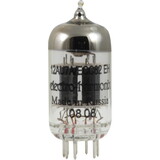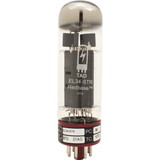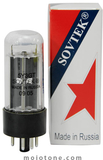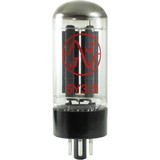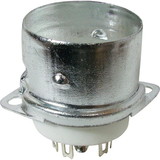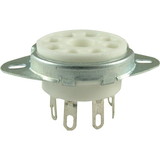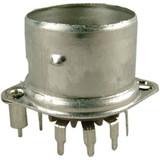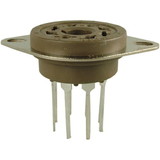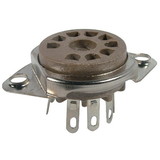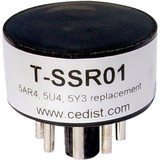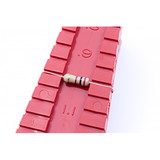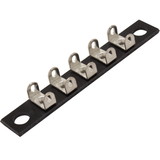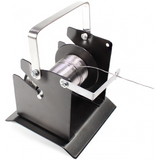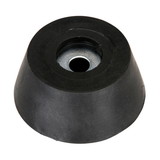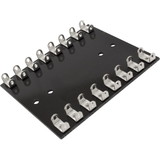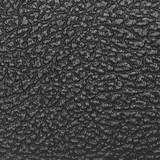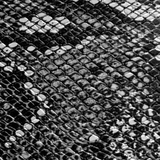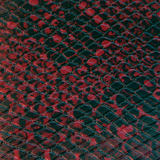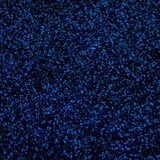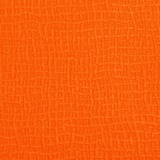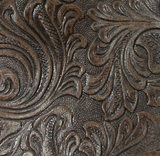Yellow Jackets P-YJR Solid State Rectifier - Yellow Jackets® YJR, For 5AR4, 5U4, 5Y3
* Click "Add to Cart" to calculate shipping and delivery time.
Product Description
Manufacturer Part Number: P-YJR
The YJR is a direct plug-in replacement adapter for use in most amplifiers that use 5AR4/GZ34, 5U4, 5Y3 or similar full-wave rectifier tubes. The YJR converts your amp's vacuum tube rectifier to a solid state rectifier, reducing tube sag for a tighter sound and feel. The tube rectifier can easily be swapped back in when sag is desired. This Yellow Jacket® is a solid state device and as such does not come with vacuum tubes.
All Yellow Jackets® have a one year warranty against manufacturer defects.
Measurements and Specs
Files
The YJR is a direct plug-in replacement adapter for use in most amplifiers that use 5AR4/GZ34, 5U4, 5Y3 or similar full-wave rectifier tubes. The YJR converts your amp's vacuum tube rectifier to a solid state rectifier, reducing tube sag for a tighter sound and feel. The tube rectifier can easily be swapped back in when sag is desired. This Yellow Jacket® is a solid state device and as such does not come with vacuum tubes.
- Converts most audio amplifiers which use a vacuum tube rectifier 5AR4/GZ34, 5U4 or 5Y3 to a solid state device.
- Safe for all common amplifiers and transformers.
All Yellow Jackets® have a one year warranty against manufacturer defects.
Measurements and Specs
| Item Diameter | 1.301 in. | |
| Item Height | 0.82 in. |
| Packaging Dimensions | 4.75 in. × 3.5 in. × 1.315 in. | |
| Weight (Packaging) | 0.266 lbs. |
Files
| YJR Instruction Sheet | All Models |
 Attention CA Residents: Prop 65 Warning
Attention CA Residents: Prop 65 Warning
 WARNING:
This product can expose you to chemicals which are known to the State of California to cause cancer, birth defects, or other reproductive harm. For more information, go to www.p65warnings.ca.gov.
WARNING:
This product can expose you to chemicals which are known to the State of California to cause cancer, birth defects, or other reproductive harm. For more information, go to www.p65warnings.ca.gov.
Need more information?
Our staff are available to answer any questions you may have about this item
Our staff are available to answer any questions you may have about this item
Customer Reviews
By S. Patterson
Date: April 26, 2022
Replaced the blown rectifier in a Mesa Boogie Lonestar Special (30W) with this and it is so pleasantly buzzy. The LSS was a little too flabby in the bass anyhow. Sounds better than the tube IMO.
Rating:  [5 of 5 Stars!]
[5 of 5 Stars!]
 [5 of 5 Stars!]
[5 of 5 Stars!]
By V. Brown
Date: August 30, 2021
There is so much misinformation on this page that I thought I might add some technical information.This Yellow Jacket semiconductor rectifier is composed of standard solid state diodes. Now, solid state diodes come in many different types, obviously, since they come in different voltage and current ratings, but also, more important, different material of composition. Standard solid state diodes suffer from turn on and turn off noise and so new types of diodes were invented to mitigate the noise. These are the high speed fast recovery diodes such as the Schottky diode. These Yellow Jacket replacements are composed of the noisy p n junction silicone diode. Those who do it yourself (a very simple job) would use the Schottky diodes and the two diodes would cost about $20; so you can see why they are not used in the Yellow Jacket.There is considerable confusion about power supply sag. Any power supply has internal resistance. The power transformer itself has resistance in both the primary and secondary windings. Any competent supply (but not necessarily a guitar amp PS) will have a Pi filter composed of a capacitor, inductor, and capacitor. The inductor has a certain resistance that adds to the internal resistance of the power supply too, but it is very effective at eliminating much of the hum. Cheaper power supplies use a resistor instead that, obviously, add resistance to the supply increasing its internal impedance.The sag is simply a function of the internal impedance of the power supply. As more current is drawn from the supply under loud passages or power chords, the internal resistance of the supply drops more voltage: Ohm's law at work! So the higher the impedance of the power supply, the more voltage is dropped; it is that simple. Solid state diodes have a lower resistance than a tube rectifier and, in the same amp, this will increase the power supply voltage.As an example, if we have an amplifier that pulls 300mA from the power supply at idle, Ohm's law tells us that, if the power supply has an internal impedance of 200ohms, it will drop .3 x 200 = 60 volts. If we have a loud passage and 350mA is drawn from the PS, it will drop .35 x 200 = 70Volts. The power supply voltage has dropped by 10V. That is power supply sag!
Rating:  [4 of 5 Stars!]
[4 of 5 Stars!]
 [4 of 5 Stars!]
[4 of 5 Stars!]
By Bill Hambone
Date: May 24, 2021
I popped this in my 2003 Orange AD30 single channel head, because I wanted to see if I could cut down on low end sag. I grew up playing a vintage Brownface Fender with an SS rectifier, and I'm used to that tight low end. I feel like this has made a huge improvement in the Orange. I play a lot of chords, and not much lead guitar stuff. Great $18 investment!!
Rating:  [5 of 5 Stars!]
[5 of 5 Stars!]
 [5 of 5 Stars!]
[5 of 5 Stars!]
By baba515
Date: March 30, 2021
I use it in conjunction with a variac to reform capacitors in old tube amps. The solid state rectifier produces DC voltage right from the get go where tube rectifier doesn't until filament heats sufficiently. This allows you to start variac at very low setting to reform caps. Starting at 5 and stepping up 5 every hour. Its indispensible for this task.
Rating:  [5 of 5 Stars!]
[5 of 5 Stars!]
 [5 of 5 Stars!]
[5 of 5 Stars!]
By flummox
Date: July 21, 2020
I installed this in my Marshall JTM45 clone to tighten up the bottom end and eliminate a point of failure. Works great. It WILL change the behaviour of your tube-rectified amp - it'll be stiffer and less compressed at high volumes, so if you want something that acts more like a tube I suggest a Weber Copper Cap. But I knew what I was getting and this does the trick just fine for me.
Rating:  [5 of 5 Stars!]
[5 of 5 Stars!]
 [5 of 5 Stars!]
[5 of 5 Stars!]
By Wizard of WID
Date: May 07, 2016
This solid state rectifier is my preferred replacement for any vacuum tube rectifier. None of the other reviews I have read mentions a CRITICAL piece of advice that is printed on the back of the very small owner's advice packed in with the Yellow Jacket - If simply plugged in in place of a vacuum tube rectifier, the high voltage DC in your amp will come on instantly. however your power tubes are not ready for that. Full DC voltage on power tubes with cold cathodes will damage them. Solution? Install a "standby" switch to allow a warmup time, maybe 30 to 60 seconds, so that the other tubes' cathodes will be already hot when the DC voltage from the Yellow Jacket comes on. The details of that will be easy for any good old-time electronics geek: if you are not one, find a friend who is. On my amp, I installed a two-pole switch on both sides of the 670 volt AC transformer winding that feeds the two anodes of the rectifier tube.
Rating:  [5 of 5 Stars!]
[5 of 5 Stars!]
 [5 of 5 Stars!]
[5 of 5 Stars!]





